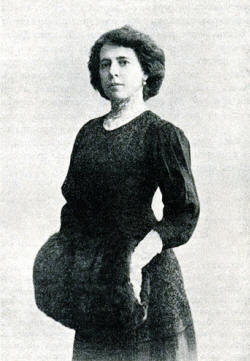

Queer Places:
Smolensky Cemetery
Saint Petersburg, Saint Petersburg Federal City, Russia
 Lidia
Alekseyevna Charskaya (January 31, 1875 – March
18, 1938) was a Russian writer and actress. Charskaya was her pseudonym; her
real last name was Churilova. Pre-revolutionary Russian lesbian literature
includes such well-known names as
Zinaida Gippius, Lidia
Zinovieva-Annibal,
Yevdokiya Nagrodskaya, Lidia Charskaya,
Marina Tsvetayeva and Sofia Parnok.
These writers are all very different in their talents, world view, and in the
way they approach the lesbian theme, yet all of them together comprise an
artistic stratum that we can certainly refer to as a Russian lesbian
subculture. And this applies not only to their works, but also to their
artistic image and the literary and artistic world in which many of them
played an important role at the beginning of the twentieth century. We can
therefore say that by 1917 a lesbian subculture had undoubtedly taken shape in
Russia. It continued until the early 1930s when almost all the spiritual
traditions of the past underwent transformation; the old relations collapsed,
spiritual continuity disappeared forever, leaving behind only fragmentary and
local centres of culture. A new kind of person, a new system of values and a
new type of relationship began to take shape within the lesbian subculture.
Lidia
Alekseyevna Charskaya (January 31, 1875 – March
18, 1938) was a Russian writer and actress. Charskaya was her pseudonym; her
real last name was Churilova. Pre-revolutionary Russian lesbian literature
includes such well-known names as
Zinaida Gippius, Lidia
Zinovieva-Annibal,
Yevdokiya Nagrodskaya, Lidia Charskaya,
Marina Tsvetayeva and Sofia Parnok.
These writers are all very different in their talents, world view, and in the
way they approach the lesbian theme, yet all of them together comprise an
artistic stratum that we can certainly refer to as a Russian lesbian
subculture. And this applies not only to their works, but also to their
artistic image and the literary and artistic world in which many of them
played an important role at the beginning of the twentieth century. We can
therefore say that by 1917 a lesbian subculture had undoubtedly taken shape in
Russia. It continued until the early 1930s when almost all the spiritual
traditions of the past underwent transformation; the old relations collapsed,
spiritual continuity disappeared forever, leaving behind only fragmentary and
local centres of culture. A new kind of person, a new system of values and a
new type of relationship began to take shape within the lesbian subculture.
Charskaya worked as an actress at the Alexandrinsky Theatre from 1898 to 1924. From 1901 to 1916 she published about eighty books, several of which became bestsellers. Her most popular work was the novel Princess Dzhavakha (1903).[1] In the 1940s, when Boris Pasternak was writing his novel Doctor Zhivago, he said that he was "writing almost like Charskaya", because he wanted to be accessible and dreamed that his prose would be gulped down "even by a seamstress, even by a dishwasher."[2]
Her novels fall into four general categories: stories that take place in boarding schools for elite girls; historical novels about women; autobiographical novels that follow the heroine from boarding school to a career; and detective and adventure stories. The main theme of most of her works is friendship among girls. The protagonists are usually independent girls and women who look for adventure or some kind of diversion from the everyday routine. Critics have commented that these characteristics account in large part for the wide popularity of Charskaya's works among young girls in early 20th century Russia.[1]
Charskaya's reputation began to fade in 1912 after the critic Korney Chukovsky published an article in which he wrote that her books were formulaic, repetitious, and excessive with respect to female emotions. She stopped publishing in 1916, and in 1920 her works were banned. From 1924 until her death in 1938 she lived in poverty, supported mostly by friends. Throughout the Soviet period her work was lowly regarded, although there is plenty of evidence that young girls continued secretly to read her works, at least through the 1930s. In the late 1980s and 1990s Charskaya's works were revived in Russia, as several of her works appeared in new editions.[1]
My published books: